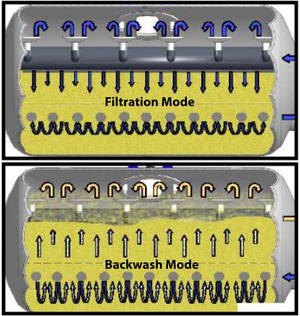
Sand filters have been around since the 1940s, and they have been the “go to” solution for drinking water systems and pools of all sizes for decades. The early sand filters were very large, vertical “rapid sand” filters that moved the water very slowly (about 3 gallons per minute per sq ft of filter area) across a relatively thin layer of pool sand (or media) which did the actual filtering. That media was supported by different layers of gravel, that were just there to support the sand and the bottom laterals. The water quality was supposedly great, although we were only around to see the last of them getting removed.
In the mid-late 1980s, sand filter technology dramatically changed to more horizontal-shaped filters, shown here. The gravel support layer for the media was mostly gone, and the water was propelled through the filters at a much faster rate… getting the name “high-rate” sand. The water quality for these types of filters could be tweaked by experienced companies… all the way to EPA-approved drinking water media, but had been misapplied by many others, leaving customers wanting better. The flow through the filters was increased up a maximum of 20 GPM per sq ft, although best practice was closer to 15 GPM.
Now in 2021, new European and domestic research points out that terrific water quality gains are possible in slowing the flow down even further, down to 10-12 GPM per sq ft of filter area or a maximum of 4-times faster than the original rapid sand filters. This design change, in combination with AFM® Activated Glass Media, APF® PolyFloc, and deep enough sand beds (a standard feature in CES filters, but not always found in others) can combine to provide “SUB MICRON” filtration. This is a huge advancement since SOME sand filters are thought to provide only 20-micron filtration.
Some CES customers have upgraded their facilities, having made the transition to this new standard of filtration, and the results have been great. Also, this new sizing criteria is being recommended on all new projects as well, and has been adopted by leading engineering firms across the US and abroad.
You don’t necessarily need to change your filters to experience the new technology. Some customers are using the AFM® and APF® upgrade, along with CES’s direct control of pumping systems to put their existing filters into a super “SUB MICRON” mode during off peak times as allowed by DOH codes.
Contact your CES rep to see if it makes sense to look into any of these filtration upgrades in the future, and to see if your existing system can easily be upgraded to these exciting new technologies.





